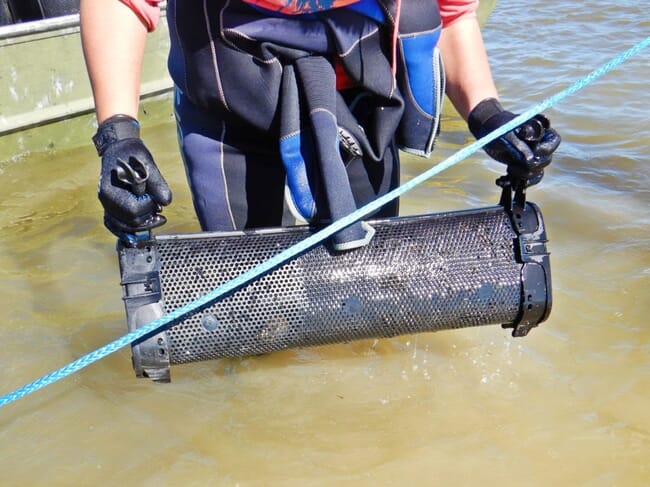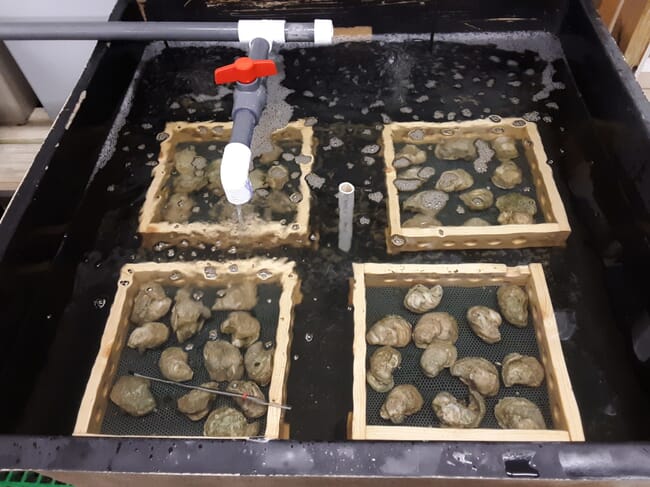
© Texas A&M AgriLife
So believe experts from Texas A&M AgriLife, who have released a paper outlining the huge potential of the sector in the year ahead.
Oyster aquaculture is worth over $200 million in the US. However, Texas was the last coastal state in the nation to allow commercial oyster farming, only permitting it after the passage of two bills in September 2019. Since then, the Texas Parks and Wildlife Department has developed the rules and regulations related to oyster aquaculture in Texas.
“One sure indication of the interest in and optimism for the industry is that several groups have applied for permits to grow oysters commercially on the Texas coast,” Dr Joe Fox, a former Texas A&M AgriLife Research scientist who is now Marine Resource Chair with the Harte Research Institute, HRI, for Gulf of Mexico Studies told Paul Schattenberg at Texas A&M AgriLife. “The permitting process is daunting but will likely become more streamlined as both regulatory agencies and operators become more familiar with the process and farming itself.”
Dr Fox, who has spent years working with legislative and business leaders to help bring this type of aquaculture to Texas, said many of the pieces are coming together to create a strong foundation for successful commercial oyster aquaculture.
“Bringing sustainable commercial aquaculture to the Texas Gulf Coast will provide jobs and new economic opportunities for many coastal communities in the state,” said Dr Juan Landivar, director of the Texas A&M AgriLife Research and Extension Center in Corpus Christi. “We have an opportunity to claim our portion of the commercial oyster industry by developing a quality product that is unique and distinctive from that produced in other Gulf states.”

© Texas A&M AgriLife
Broodstock
Among the factors making oyster farming in the Texas Gulf a possibility is the work of Dr Hugo Magaña, associate research scientist with the Texas A&M AgriLife Research Mariculture Laboratory. Magaña has been able to create the conditions under which oysters can successfully spawn in a laboratory setting.
“The ability to get oysters to spawn in the lab will eliminate the need to collect oysters every year to produce larvae,” Magaña said. “These oysters can be retained over their lifespan and produce year after year, providing a reliable supply for the commercial aquaculture industry.”
The lab will produce oyster seed for commercial growers and work on oyster genetics, including developing oyster lines that are well-suited to the unique environmental conditions along the Texas coast.
“We’re currently developing the capacity to spawn and grow oysters in a hatchery setting at our mariculture laboratory facility in Flour Bluff,” said Dr Chris Hollenbeck, AgriLife Research lead scientist at the Flour Bluff laboratory facility. “We’re also starting to lay the groundwork for a selective breeding program, which will allow us to produce oysters with superior traits for the industry.”
A Chancellor’s Research Initiative grant through The Texas A&M University System is helping provide funding for Magaña, Hollenbeck and others to develop this breeding program. The program’s objective will be to improve not only biological traits such as salinity tolerance and disease resistance, but also address how to breed oysters with certain sensory and/or nutritional qualities that will appeal to the consumer.
Moving the oyster industry forward
As Texas does not yet have a commercial hatchery for the production of juvenile or seed oysters for aquaculture, the research being done at the mariculture lab and through an AgriLife Research partnership with HRI in the Oyster Resource and Recovery Center will be vital to developing and sustaining the industry.
The centre will produce organisms for local aquaculture and restoration efforts and provide a source of replacement oysters for those affected by catastrophic events. It will also be involved in educating producers about environmentally sustainable production and harvesting methods.
Texas has until 2027 to develop its own line of tetraploid oysters for creation of the type of triploid oysters commonly used in other states.
Commercial production of triploid oysters, which are known for their sterility and superior performance, is achieved by crossing individuals with different numbers of chromosomes in a manner similar to the way seedless watermelon or bananas are produced. Regular oysters, called diploids, contain 20 chromosomes. Crossing diploid oysters with tetraploid oysters with 40 chromosomes produces triploids with 30 chromosomes.
Triploids are ideal for commercial production, and the development of viable tetraploid oysters is the key to this process. The development of these oysters would likely be a major joint research effort between PMAR/HRI and AgriLife Research.
Helping new entrants into oyster aquaculture
Mario Marquez, a Texas Sea Grant aquaculture specialist based in Palacios, has ben hired to facilitate the development of the commercial aquaculture industry.
“This includes helping the oyster farmer with the permitting process, locating vendors for aquaculture equipment, finding suppliers for seed oysters, maintaining their operation and identifying potential buyers for their oysters,” Marquez said. “I can also advise them on where to set up their lease and what type of oyster grow-out system might be best for their operation.”
“When you think about it, the opportunities in the Texas commercial oyster aquaculture industry are similar to those of the microbrewery industry,” he said. “People are willing to pay a little more for a quality product with a unique taste profile. And it also helps if the product is produced locally and has a good ‘story’ to go with it. I think producing premium half-shell oysters specific to certain areas of the Texas Gulf Coast will make a both a great experience and story for the consumer.”



